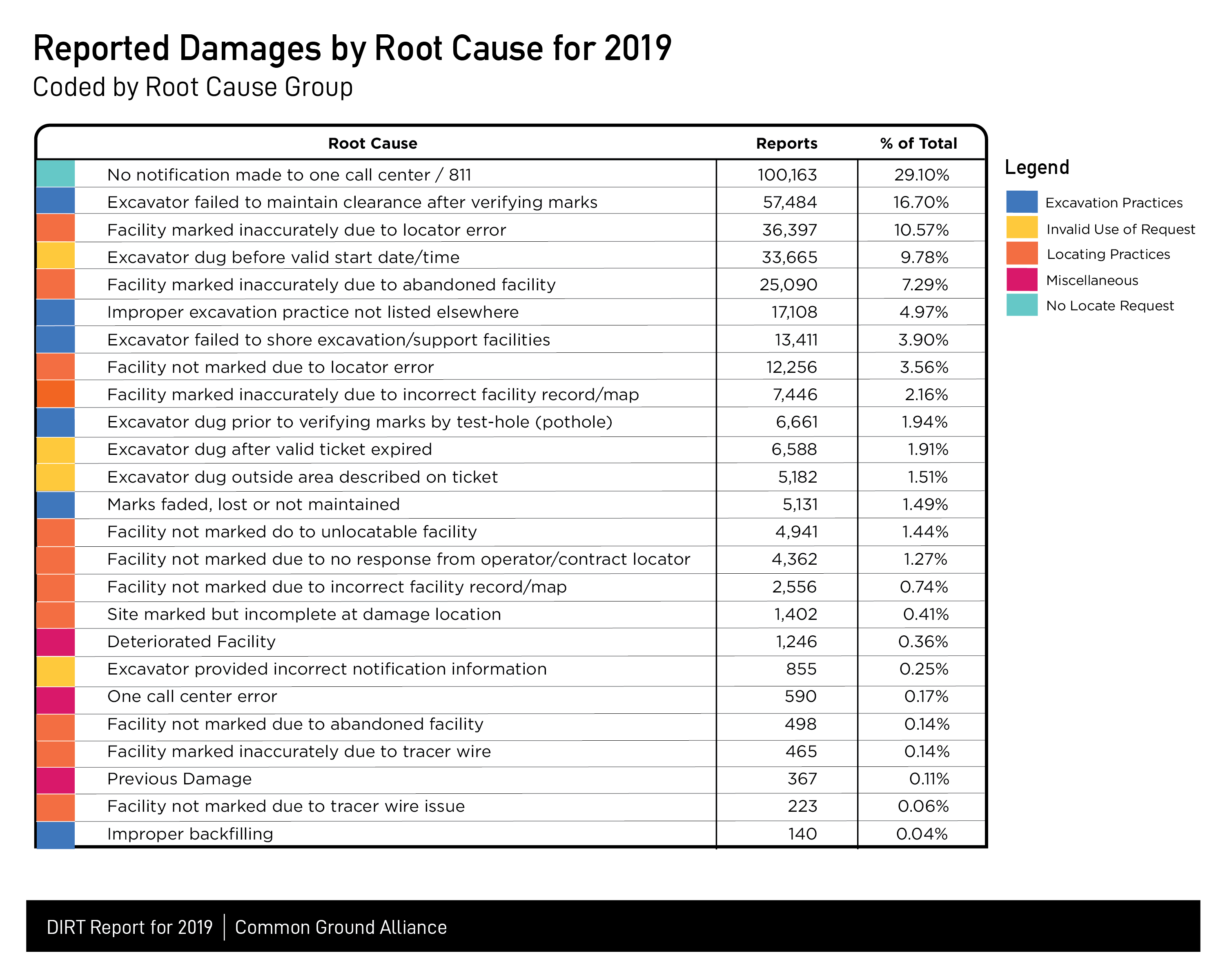Interested in Safety?
Get Safety articles, news and videos right in your inbox! Sign up now.
Safety + Get AlertsThe Common Ground Alliance (CGA), a national nonprofit trade association dedicated to protecting underground utility lines and the people who dig near them, recently announced the findings from its 2019 Damage Information Reporting Tool (DIRT) Report.
The report analyzed all 2019 data submitted voluntarily by facility operators, utility locating companies, one-call centers, contractors, regulators and others from the U.S. and Canada using an in-depth statistical modeling process. The results of this analysis found that an estimated 532,000 excavation-related damages to underground facilities occurred in the U.S. in 2019, a 4.5% increase compared to the 2018 estimate of 509,000 damages.
The report also examined the direct and indirect costs of damaging underground infrastructure, and estimated that the societal costs totaled approximately $30 billion in the U.S. in 2019 alone. That figure is more than double the U.S. federal law enforcement budget for 2019, and represents a massive amount of public and private resources spent not only repairing utilities and restoring utility service but also covering property damage, medical bills, loss of commerce while businesses are interrupted or evacuated, and other indirect costs.
According to the data, estimated annual damages have trended upward since 2015, but that has largely kept pace with increasing construction activity. The 2019 data shows that for the first time, each dollar of construction spending is resulting in more transmissions from one-call centers than in years prior, a possible indicator that the volume of locate requests is putting pressure on the damage prevention process, impacting the ability of locators to complete accurate and timely locates.
The report analyzes the root causes of damages to buried infrastructure to help determine at which step in the safe excavation process incidents occur. While failure to notify the one-call center is the single largest individual root cause, contributing to 29% of damages, other root cause groupings are converging to become roughly equal: excavating issues made up 29% of damage root causes, locating issues were responsible for 28% of damages, and the invalid use of locate requests drove 14% of damages in 2019.
As damage root cause groupings become more evenly distributed, the 2019 DIRT Report provides several recommendations that the industry can implement to reduce the incidence of damages. These include reviewing CGA Best Practices that correlate with damage root causes (such as examining hand-digging and excavating within the tolerance zone), examining the pressures on locate technicians as request volume surges, emphasizing the proper use of locate requests, and developing strategies for persistent no-call damages.
“The findings from the 2019 DIRT Report are a real call to action for the damage prevention industry and the public at large — particularly the staggering $30 billion in societal costs,” says Sarah K. Magruder Lyle, president and CEO of CGA. “We have made tremendous progress over the last two decades in securing an FCC-designated national call-before-you-dig number (811), identifying best practices, and improving processes and technologies to reduce incidents of damage. However, there is still significant work to do. I’m proud that CGA’s newest endeavor — the Next Practices Initiative — is focused on encouraging innovation and new practices to address the most critical damage prevention challenges, and is committed to addressing the inefficiencies that exist throughout the system to achieve the next dramatic reduction in damages.”
“We would like to thank the committed stakeholders who submit their damage and near-miss data voluntarily to DIRT. Once again, we received a record number of data submissions and were able to increase the granularity of analysis in the 2019 report,” says Deanna Centurion, co-chair of CGA’s Data Reporting and Evaluation Committee and principal at Cyera Strategies. “In addition to reading the 2019 DIRT Report, I encourage all damage prevention advocates to explore the data using the Interactive Dashboard and consider how you can use DIRT data and analysis to reduce damages in your area.”
The complete DIRT Annual Report for 2019 is available for download at www.commongroundalliance.com, and stakeholders interested in submitting data to the 2020 report or establishing a Virtual Private Dirt account should visit the DIRT site at www.cga-dirt.com.
About the Common Ground Alliance
CGA is a member-driven association of nearly 1,700 individuals, organizations and sponsors in every facet of the underground utility industry. Established in 2000, CGA is committed to saving lives and preventing damage to North American underground infrastructure by promoting effective damage prevention practices. For more information, visit www.commongroundalliance.com.







